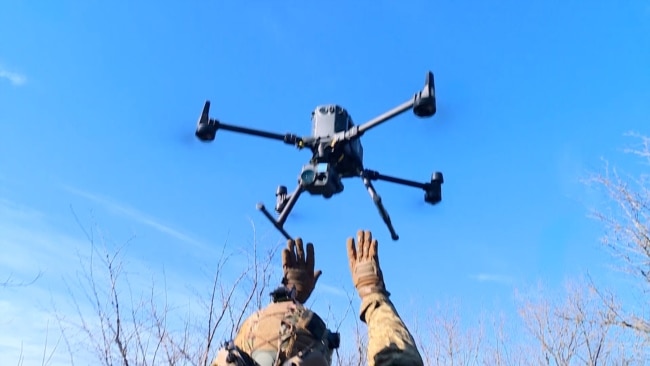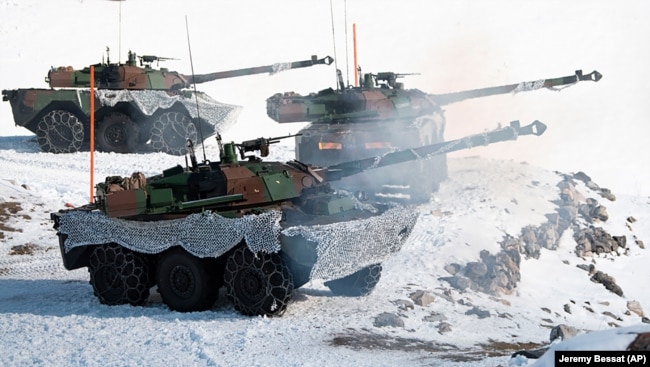Robert Coalson

In a flurry of announcements, some of Ukraine's major Western allies pledged this week to send advanced armored combat vehicles to help Kyiv in its fight against Russia's invasion.
Both the United States and Germany said they would provide new powerful weapons to Kyiv: 50 M2 Bradley fighting vehicles from Washington and 40 Marder infantry fighting vehicles from Berlin.
The January 5 announcement came a day after France made a similar pledge to send new weapons -- AMX-10 RC armored reconnaissance vehicles -- in a development that marks a clear escalation of Western military support.
Washington was expected to reveal details of its latest military-aid package on January 6.
While representing a significant upgrade in military aid, the Bradley vehicles are not atop Kyiv's main wish-list: main battle tanks, such as the U.S.-made M1 Abrams or the German Leopard.
"There is no rational reason why Ukraine has not yet been supplied with Western tanks," Zelenskiy said in a video address on January 4.
 The U.S. Bradley armored personnel carrier has been the workhorse of the U.S. military since the 1980s.
The U.S. Bradley armored personnel carrier has been the workhorse of the U.S. military since the 1980s.The developments come as Europe's largest military conflict since World War II approaches its first anniversary on February 24. Intense fighting continues in eastern and southern regions, with Moscow regularly carrying out missile and drone strikes targeting Ukraine's civilian energy infrastructure and causing regular cutoffs of electricity, heating, and water across the country.
Ukrainian officials have also been warning that Moscow could be planning a major offensive in coming weeks.
But what exactly is the West providing now, and are its infantry fighting vehicles a step toward providing the heavy armor that Kyiv craves?
Tank Killers
The Bradley has been the workhorse of the U.S. military since the 1980s. The vehicle destroyed more enemy tanks in combat in Iraq than the Abrams tank, according to Military-today.com.
"The Brad...is NOT a tank," wrote retired U.S. Lieutenant General Mark Hertling on Twitter," but it can be a tank killer…and a troop carrier."
Bradleys can provide "support of both offensive and defensive operations, providing a level of firepower and armor that will bring advantages on the battlefield as Ukraine continues to defend their homeland," Pentagon spokesman Brigadier General Pat Ryder said on January 5.
 "The Brad...is NOT a tank," wrote retired U.S. Lieutenant General Mark Hertling on Twitter," but it can be a tank killer…and a troop carrier."
"The Brad...is NOT a tank," wrote retired U.S. Lieutenant General Mark Hertling on Twitter," but it can be a tank killer…and a troop carrier."Germany's Marder, meanwhile, is also considered an effective antitank weapon, according to experts, supporting an antitank missile system called the MILAN, in addition to a 20-millimeter cannon.
The French vehicles, sometimes classified as a "light tank," are a highly mobile vehicle -- with wheels, not treads -- that are built around a turret-mounted 105-milimeter gun.
Hertling described the French AMX-10 RC as a "tank killer," adding it is "a great piece of kit." The vehicle is also often described as a tank "hunter."
"These are also low-maintenance, high-mileage, easy to support, and great cross-country on any kind of terrain," he added.
The West has already sent tens of billions of dollars of weaponry and military equipment to Ukraine dating even before the February 24 invasion.
WATCH: In the battle for the eastern city of Bakhmut, Ukrainian gunners are hitting Russian troops with Soviet-era Akatsiya artillery, coordinating their accuracy with multiple spotter drones, they say.

Over the summer, Washington, which alone has sent $20 billion in equipment since the invasion, took a leap forward in its armaments when it shipped sophisticated long-range artillery systems called HIMARS to Ukraine. HIMARS are widely believed to have played a decisive role in Ukraine's counteroffensives in Kharkiv and Kherson.
Still, Ukraine has been asking for more, including heavy tanks to go head-to-head with Russia's own formidable tanks, which have played a significant part in its invasion force since the beginning. The workhorse of Russia's armored personnel carrier fleet has long been the BMP-3.
Before the invasion, Ukraine's own armored vehicle arsenal numbered around 6,500 tanks, according to official statements, plus around 7,000 combat vehicles. The overwhelming majority of that was aging, Soviet-era equipment, sometimes in dubious repair.
In the past 10 months, Ukraine has also received more than 230 Soviet-era tanks from the Czech Republic and Poland.
 The French AMX-10 RC vehicles, sometimes classified as a "light tank," are a highly mobile vehicle -- with wheels, not treads -- that are built around a turret-mounted 105-milimeter gun.
The French AMX-10 RC vehicles, sometimes classified as a "light tank," are a highly mobile vehicle -- with wheels, not treads -- that are built around a turret-mounted 105-milimeter gun.Ukraine's military claims to have destroyed over 3,000 of Russia's tanks. And the independent Dutch research group Oryx, which keeps a running total of documented incidents of Russian military equipment knocked out of commission, puts the figure at about 1,600 tanks.
In addition to directly confronting that threat, experts said the Western infantry fighting vehicles will give Ukrainian ground troops relatively safe and speedy mobility. The vehicles are intended to enable infantry to keep up with and support armored attacks by heavy tanks.
While the new equipment does not answer Kyiv's pleas for tanks, it could pave the way for such a move in the future by giving Ukraine's military the tools need to support its own tank fleets and deploy them more effectively.
'The Time For Taboos Has Passed'
Despite this clear escalation of military assistance, the West remains reluctant to provide the heavy tanks for which Kyiv has been clamoring. Kyiv has also been asking for advanced fighter jets, like the U.S. F-16.
"Disappointing signals from Germany while Ukraine needs Leopards and Marders now," Ukrainian Foreign Minister Dmytro Kuleba posted on Twitter in September, before the Marder package materialized. "Not a single rational argument on why these weapons cannot be supplied, only abstract fears and excuses. What is Berlin afraid of that Kyiv is not?"
In a post on Facebook after the announcement of the Bradleys and Marders, Kuleba hailed the breakthrough and seemed to continue pressing for tanks.
"The time for taboos on weapons has passed," he wrote. "We are entering the decisive phase. There can only be one goal: Ukraine's victory."
During Zelenskiy's visit to Washington in December, U.S. President Joe Biden expressed fear that providing advanced tanks and long-range weaponry could break NATO's unity in supporting Ukraine.
"They are not looking to go to war with Russia," Biden said of NATO members. The United Kingdom, which has been among the most generous Western providers of lethal assistance, has also balked when it comes to tanks.
German Defense Minister Christine Lambrecht struck a similar note in September.
"We have reached an understanding with our partners that Germany won't go it alone," she said.
 During Zelenskiy's visit to Washington in December, U.S. President Joe Biden expressed fear that providing advanced tanks and long-range weaponry could break NATO's unity in supporting Ukraine.
During Zelenskiy's visit to Washington in December, U.S. President Joe Biden expressed fear that providing advanced tanks and long-range weaponry could break NATO's unity in supporting Ukraine.However, German Foreign Minister Annalena Baerbock hinted at a softer position in September.
"We have to decide this together…. But the decisive phase in Ukraine is right now and I don't think it's a decision that should be delayed too long," she told Frankfurter Allgemeine Zeitung.
In addition, U.S. defense officials have said Ukraine already has enough tanks. Moreover, the Abrams, they say, is a difficult machine to operate and maintain.
"I think it is really a question of sustainability," The Economist Defense Editor Shashank Joshi said in an interview with France 24 television.
"New tanks use an awful lot of fuel -- Abrams in particular are extremely fuel hungry," he added. "Maintenance takes a lot of effort, while spare parts are in huge demand…. So practical concerns are at the forefront of U.S. calculations here."
No comments:
Post a Comment